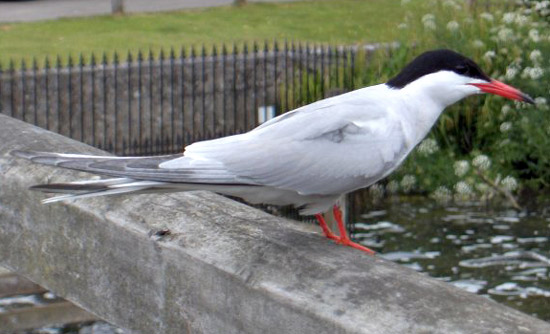| Kingdom: Animalia Phylum: Chordata Class: Aves (Birds) Order: Charadriiformes Family: Laridae |
 Common Tern (Sterna hirundo) Common tern (Sterna hirundo) is a widespread winter visitor and a probable resident in India. Size: 32-35 cm This bird breeds in the northern parts of the Northern Hemisphere and winters from southern areas in the Northern Hemisphere south to the Southern Hemisphere. This bird The habitat of this species is lakes, bays, and sea coasts. Although fish compose 90% of the diet of the common tern, it also consumes some aquatic invertebrates, including crustaceans and insects. This species is a colonial nester. The nest is on the ground or on rafts of floating vegetation or on muskrat lodges. The two or three eggs, rarely four, are incubated by both parents, but mainly by the female, for twenty to twenty-three days. Young are semi-precocial - they may leave the nest after three days and soon are able to swim. They are tended by both parents and begin to fly about four weeks after hatching. Description: Adults in summer: Mantle of pearly gray across back and wings; whole top of head black; sides of head, throat and tail white; breast and belly very pale gray; tail forked; outer web of outer tail feathers gray; bill red at base, black at tip; feet red. Adults in winter: Similar but only hind part of crown is black; forehead white. Juveniles: Similar to winter adults but back somewhat mottled and buffy, tails much shorter, and distinctive dark mark on the inner forewing. Breeding: Nest is a mere depression scraped out in the turf or sand, sometimes with a lining. In my experience, nests always occur in colonies numbering from a few to many hundred pairs, usually on coastal islands but sometimes on mainland beaches remote from human intrusion or on islets in freshwater lakes. The species breeds extensively on lakes elsewhere in its range. Eggs: 3; olive-green to olive-brown, heavily marked with dark brown blotches, usually heaviest around the larger end. A visit to a colony of nesting terns, particularly a large one, is an experience long remembered. As the nesting ground is approached, the angry birds come to meet the intruder scolding vociferously. When the nests are reached, the harsh, screaming tearr, tearr, tearr reaches its highest pitch, and is accompanied by savage dive-bombing, as with folded wings the birds drop at terrific speeds to within centimetres of the intruder, sometimes spraying him with highly odoriferous, regurgitated fish. |
 birding.in
birding.in
| Birds | Bird Diagram | Ornithology | Indian Sites | Bird Watching | Migration | North India | Birds of India | Haryana |
All rights reserved. Copyright © 2005-2013 Birds and birding in India. Disclaimer
website: Free Java Guide & Tutorials